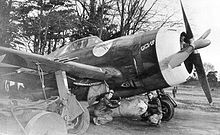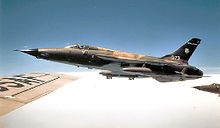
Royal Air Force Bodney or more simply RAF Bodney is a former Royal Air Force Station located 4.5 miles (7.2 km) west of Watton, Norfolk, England.

The 103rd Airlift Wing is a unit of the Connecticut Air National Guard, stationed at Bradley Air National Guard Base at Bradley International Airport, Windsor Locks, Connecticut. If activated to federal service with the United States Air Force, the 103 AW is operationally-gained by the Air Mobility Command (AMC).

The 113th Wing, known as the "Capital Guardians", is a unit of the District of Columbia Air National Guard, stationed at Joint Base Andrews, Maryland. If activated to federal service, the fighter portion of the Wing is gained by the United States Air Force's Air Combat Command, while the airlift portion is gained by Air Mobility Command.
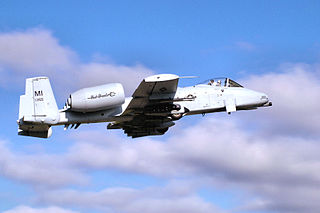
The 127th Operations Group is a unit of the Michigan Air National Guard. It is stationed at Selfridge Air National Guard Base and is one of two flying groups assigned to the 127th Wing. The group operates Fairchild Republic A-10 Thunderbolt II ground attack aircraft.

The 121st Fighter Squadron is a unit of the District of Columbia Air National Guard 113th Wing located at Joint Base Andrews, Camp Springs, Maryland. The 121st is equipped with the Block 30 F-16C/D Fighting Falcon.
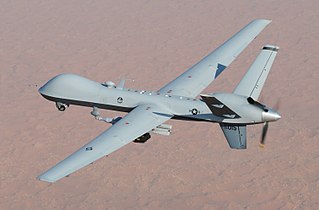
The 136th Attack Squadron is a unit of the New York Air National Guard 107th Attack Wing located at Niagara Falls Joint Air Reserve Station, New York. The 136th is equipped with the MQ-9 Reaper. If activated to federal service, the Wing is gained by the United States Air Force's Air Combat Command.

The 142d Airlift Squadron is a unit of the Delaware Air National Guard 166th Airlift Wing located at New Castle Air National Guard Base, Delaware. It is equipped with the C-130H Hercules.

The 167th Airlift Squadron is a unit of the West Virginia Air National Guard 167th Airlift Wing located at Shepherd Field Air National Guard Base, Martinsburg, West Virginia. It is equipped with the C-17 Globemaster III, heavy airlifter.

The 119th Fighter Squadron is a unit of the New Jersey Air National Guard 177th Fighter Wing located at Atlantic City Air National Guard Base, New Jersey. The 119th is equipped with the F-16 Fighting Falcon aircraft and is the oldest active flying fighter squadron in the Air National Guard.

The 54th Fighter Squadron is an inactive United States Air Force unit. Its last assignment was to the 3d Operations Group, being stationed at Elmendorf Air Force Base, Alaska. It was inactivated on 28 April 2000.
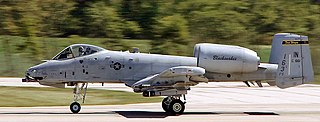
The 163rd Fighter Squadron is a unit of the Indiana Air National Guard's 122nd Fighter Wing, located at Fort Wayne Air National Guard Station, Indiana. The 163rd is currently transitioning from the A-10 Thunderbolt II to the F-16 Fighting Falcon.

The 148th Fighter Squadron is a unit of the Arizona Air National Guard 162d Fighter Wing located at Tucson Air National Guard Base, Arizona. The 148th is equipped with the Block 20 F-16A/B Fighting Falcon. The squadron was first organized in England during World War II, moving to North Africa shortly after the invasion. It participated in combat in the Mediterranean Theater of Operations, where it earned a Distinguished Unit Citation. The squadron returned to the United States after V-E Day and was inactivated.

The 149th Fighter Squadron is a unit of the Virginia Air National Guard's 192d Fighter Wing located at Joint Base Langley–Eustis, Virginia. The 149th is the first Air National Guard fighter squadron to fly the F-22 Raptor.

The 113th Air Support Operations Squadron is a unit of the Indiana Air National Guard 181st Intelligence Wing located at Terre Haute Air National Guard Base, Indiana.

The 357th Fighter Squadron is part of the 355th Fighter Wing at Davis–Monthan Air Force Base, Arizona. It operates Fairchild Republic A-10 Thunderbolt II aircraft training pilots for close air support missions.
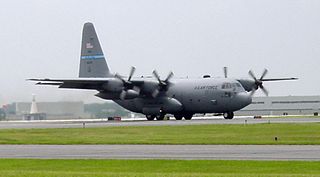
New Castle National Guard Base is a United States Air Force installation under the control of the Delaware Air National Guard, located at Wilmington Airport in New Castle County, Delaware.
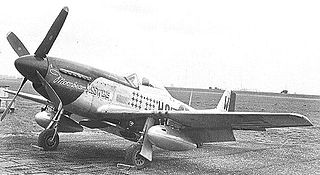
The 487th Fighter Squadron is an inactive United States Air Force unit. It activated during World War II and was assigned to the 352nd Fighter Group of VIII Fighter Command. After training in the United States, it deployed to the European Theater of Operations, where it earned two Distinguished Unit Citations and a French Croix de Guerre with Palm for its combat actions. Following V-E Day, it returned to the United States and was inactivated at the port of embarkation, Camp Kilmer, New Jersey, on 9 November 1945.

The 352nd Fighter Group was a unit of the Eighth Air Force that was located in the European Theater of Operations during World War II. The unit served as bomber escort, counter-air patrols, and attacking ground targets. It initially flew P-47 Thunderbolt aircraft before converting to P-51 Mustang in April 1944. The group was located at RAF Bodney in England for the majority of its service and were nicknamed the Blue-nosed Bastards of Bodney due to the distinctive blue of the nose and upper cowl of the P-51 Mustangs of the group.

The 172nd Attack Squadron is a unit of the Michigan Air National Guard 110th Wing located at Battle Creek Air National Guard Base, Battle Creek, Michigan. The 172nd is equipped with the MQ-9 Reaper drone.
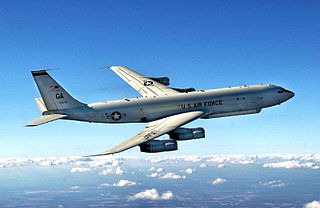
The 116th Operations Group is a Georgia Air National Guard unit assigned to the 116th Air Control Wing. The unit is stationed at Robins Air Force Base, Georgia. The 116th Group controls all operational Northrop Grumman E-8C Joint STARS aircraft of the 116th Air Control Wing. It was activated in 1992, when the Air Force implemented the Objective Wing organization, and was successively equipped with the McDonnell Douglas F-15 Eagle and the Rockwell B-1 Lancer before converting to the E-8C in 2002.



